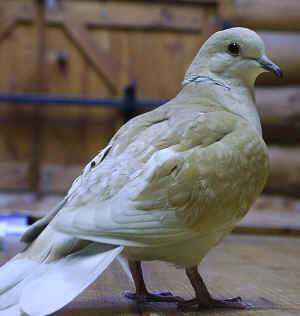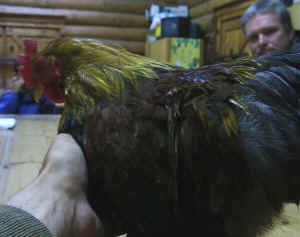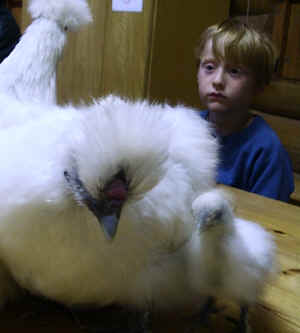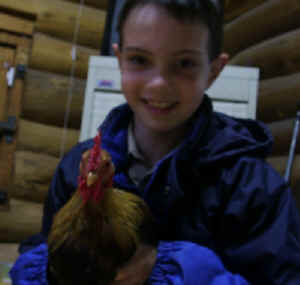| This Young Rangers' Club meeting was on an evening
with appalling weather. As a result, some of the club members sadly missed out on meeting
some of Ranger Alan's birds, which he had brought in to show the Young Rangers. This was a good opportunity to have a look at some of the rarer breeds of
poultry and to marvel at the enormous numbers of different varieties produced from the
original wild Jungle Fowl, as a result of breeding and artificial selection.
 |
Before the introductions were
made, the Young Rangers wrote letters and made pictures for Polly to thank her for the pond party. |
 |
The first bird on show
was a Barbary Dove. This bird is very quiet and all the children were able to handle it. Barbary Doves are very similar to the wild Collared Dove which can often be
found in gardens at bird tables.
Barbary Doves are not a native species, but arrived in Britain in
the 1950s and have now become widespread. |
 |
The next bird was a young
cockerel called Junior. Junior is a Bantam Partridge Peking.
A 'Bantam' is a type of small domestic fowl. 'Partridge' refers to the colour of the bird,
while 'Peking' is included in the name because the breed originates from the vicinity of
Peking, China.
Pekings are all Bantams, but come in a variety of different colours.
|
 |
Next on show were two White
Silkie hens together with a 3 week old chick. This breed also
comes from China and has a number of different colour variations. Silkies are very
different from other poultry. They have blue /grey skin and get their name from their
silky soft feathers.
Silkies don`t lay a lot of eggs and are generally kept more for
their mothering abillity than for their eggs. |
| The next hen was
a Bantam Rhode Island Red (R.I.R.) with her day old chicks. The R.I.R.s come from Rhode
Island, in America. There is a large as well as a bantam version of this breed and they
are usually kept for their egg laying ability. |
 |
Lastly, the
Young Rangers looked at a variety of different types of chick which were about 9 weeks
old. |
 |
The most
interesting variety of chick was a White-topped Black Polish. These
make great pets for the garden. They come in a variety of colours and are unmistakable
with their large feather bonnets .
The breed is believed to have its origins in Russia rather than
Poland, as their name might suggest. They actually get their name from the lump or pole on
the top of their skull which they have when they hatch. This makes it easy to tell a
Polish chick from any other.
(Left: an adult White-topped Black Polish) |
Young
Rangers' Club Home Page |

